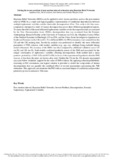- CERES Home
- →
- Cranfield Defence and Security
- →
- Staff publications (CDS)
- →
- View Item
JavaScript is disabled for your browser. Some features of this site may not work without it.
| dc.contributor.author | Giles, Stephanie | |
| dc.contributor.author | Errickson, David | |
| dc.contributor.author | Harrison, Karl | |
| dc.contributor.author | Márquez-Grant, Nicholas | |
| dc.date.accessioned | 2023-01-04T10:46:05Z | |
| dc.date.available | 2023-01-04T10:46:05Z | |
| dc.date.issued | 2022-12-09 | |
| dc.identifier.citation | Giles S, Errickson D, Harrison K, Márquez-Grant N. (2023) Solving the inverse problem of post-mortem interval estimation using Bayesian Belief Networks. Forensic Science International, Volume 342, January 2023, Article number 111536 | en_UK |
| dc.identifier.issn | 0379-0738 | |
| dc.identifier.uri | https://doi.org/10.1016/j.forsciint.2022.111536 | |
| dc.identifier.uri | https://dspace.lib.cranfield.ac.uk/handle/1826/18837 | |
| dc.description.abstract | Bayesian Belief Networks (BBNs) can be applied to solve inverse problems such as the post-mortem interval (PMI) by a simple and logical graphical representation of conditional dependencies between multiple taphonomic variables and the observable decomposition effect. This study is the first cross-comparison retrospective study of human decomposition across three different geographical regions. To assess the effect of the most influential taphonomic variables on the decomposition rate (as measured by the Total Decomposition Score (TDS)), decomposition data was examined from the Forensic Anthropology Research Facility at the University of Tennessee (n = 312), the Allegheny County Office of the Medical Examiner in Pittsburgh, US (n = 250), and the Crime Scene Investigation department at Southwest Forensics in the UK (n = 81). Two different BBNs for PMI estimations were created from the US and the UK training data. Sensitivity analysis was performed to identify the most influential parameters of TDS variance, with weaker variables (e.g., age, sex, clothing) being excluded during model refinement. The accuracy of the BBNs was then compared by additional validation cases: US (n = 28) and UK (n = 10). Both models conferred predictive power of the PMI and accounted for the unique combination of taphonomic variables affecting decomposition. Both models had a mean posterior probability of 86% (US) and 81% (UK) in favor of the experimental hypothesis (that the PMI was on, or less than, the prior last known alive date). Neither the US nor the UK datasets represented any cases below 'moderate' support for the value of PMI evidence. By applying coherent probabilistic reasoning to PMI estimations, one logical solution is provided to model the complexities of human decomposition that can quantify the combined effect of several uncertainties surrounding the PMI estimation. This approach communicates the PMI with an associated degree of confidence and provides predictive power on unknown PMI cases. | en_UK |
| dc.language.iso | en | en_UK |
| dc.publisher | Elsevier | en_UK |
| dc.rights | Attribution-NonCommercial-NoDerivatives 4.0 International | * |
| dc.rights.uri | http://creativecommons.org/licenses/by-nc-nd/4.0/ | * |
| dc.subject | Post-mortem interval | en_UK |
| dc.subject | Bayesian Belief Networks | en_UK |
| dc.subject | Inverse problem | en_UK |
| dc.subject | Decomposition | en_UK |
| dc.subject | Forensic taphonomy | en_UK |
| dc.subject | Taphonomic variables | en_UK |
| dc.title | Solving the inverse problem of post-mortem interval estimation using Bayesian Belief Networks | en_UK |
| dc.type | Article | en_UK |
Files in this item
The following license files are associated with this item:
This item appears in the following Collection(s)
-
Staff publications (CDS) [1222]

